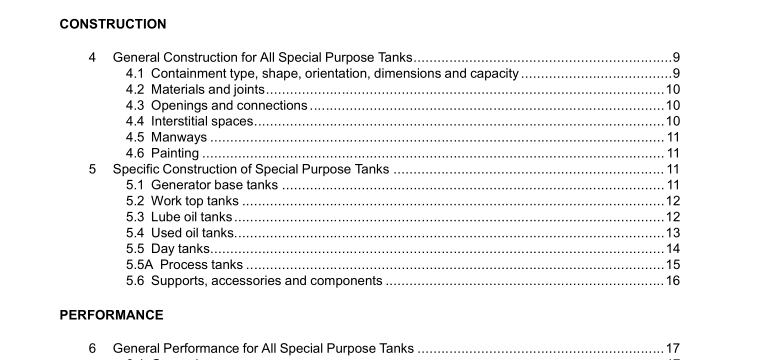UL 142A-2021 pdf download.Special Purpose Aboveground Tank for Specific Flammable or Combustible Liquids.
3.10 Performance Tests – A complete evaluation conducted on a limited quantity of representative tanks. These tests are intended to verify compliance with all applicable performance requirements in a standard. 3.11 Primary Containment – The ability of a tank design and construction to contain a liquid while in normal use (intended storage). 3.12 Primary Containment Tank (Primary Tank) – The wall of a tank construction that provides primary containment. 3.13 Production Tests – A limited evaluation conducted on each tank prior to shipping. These tests are intended to verify compliance with production requirements in a standard, such as leakage. 3.14 Secondary Containment – The ability of a tank design or construction to contain a liquid only in abnormal use (from primary containment leakage or rupture). 3.15 Secondary Containment Tank (Secondary Tank) – A primary containment aboveground tank contained within a steel secondary containment shell forming an interstitial space to the greater of 330 degrees or 95 percent fill, and which is capable of being pressurized and monitored for leakage from either the interior or exterior walls. 3.16 Special Purpose Tank – A steel aboveground tank covered by the requirements of this Standard, which are intended for specific applications and/or fuels or liquids as indicated by each special purpose tank type. a) Generator Base Tank – A special purpose tank with structural supports for mounting of power generators (such as diesel or turbine engines) or similar equipment, and intended only for storage of diesel, kerosene, turbine oil or similar combustible Class II or III fuels to supply these engines. b) Work Top Tank – A special purpose tank with a structural top working surface and optional racks/shelves, intended only for storage of heavy fuel oils, new/used lube oils, hydraulic/transmission oils, or similar maximum Combustible Class III liquids.
3.17 Storage Tank (Tank) – A vessel having a liquid capacity that typically exceeds 60 gal (230 L), is primarily intended for stationary installation, and is not used for processing. 3.18 Tank Accessory – Optional aboveground tank devices or components intended to provide a specific function, such as walking or climbing access, load bearing support, spill containment, venting or heating. 3.19 Tank Support – Optional aboveground tank steel load bearing members intended to provide tank stability and structural support without creating hazardous shell stresses. Typical supports designs include saddles, beams and legs. 3.20 Vent Opening – A tank top opening that is intended to provide separate or combined normal venting and/or emergency venting. The vent opening (s) may be either a fitting on the shell or short pipe stub attached to the fitting or shell. a) Emergency Vent – A vent opening or device that automatically relieves excessive internal pressure due to an external fire exposure or blockage of the normal vent. Emergency vents are designed and sized not to exceed a tank pressure of 2.5 psi (17.2 kPa), and are provided with a CFH flow rating at this value. b) Normal Vent – A vent opening or device that automatically relieves internal pressure or vacuum during normal storage (atmospheric pressure equalization) and during normal operations (fill or withdraw). Normal vents are designed and sized not to exceed a tank pressure or vacuum of 1.0 psig or minus 0.5 psig (6.9 kPa to minus 3.4 kPa).
4.2 Materials and joints 4.2.1 The tank and any structural part of the tank (tank or equipment supports or accessories) shall be constructed of commercial or structural grade carbon or stainless steel grades as identified in UL 142, Section 5. Only new material shall be used. 4.2.2 Welding of steel plates to fabricate the tank shall use the joint types identified in UL 142, Section 6, Table 6.1 for the specific tank geometry, and shall comply with the construction referenced in the appropriate Figures. 4.3 Openings and connections 4.3.1 The tank, or each compartment of a compartment tank shall have at least fill, withdraw, gauge and vent openings, but other optional openings may also be provided. All openings shall be made through fittings connected to the tank shell. 4.3.2 Fittings for tank openings and connection to pipes, or other devices or equipment shall be constructed in accordance with UL 142, Section 7. See Sections 8 – 10 for required markings on or near the fitting to identify the intended opening function. 4.3.3 Except for reduced or combined normal/emergency vents permitted by a special purpose tank type, separate normal and emergency vent openings shall be sized and located in accordance with UL 142, Section 8. Exception: Long bolt manwayvents are not permitted on special purpose tanks.UL 142A-2021 pdf download.
UL 142A-2021 pdf download
